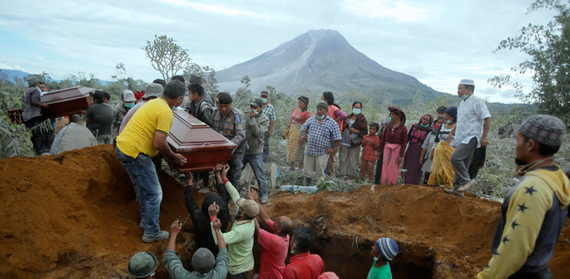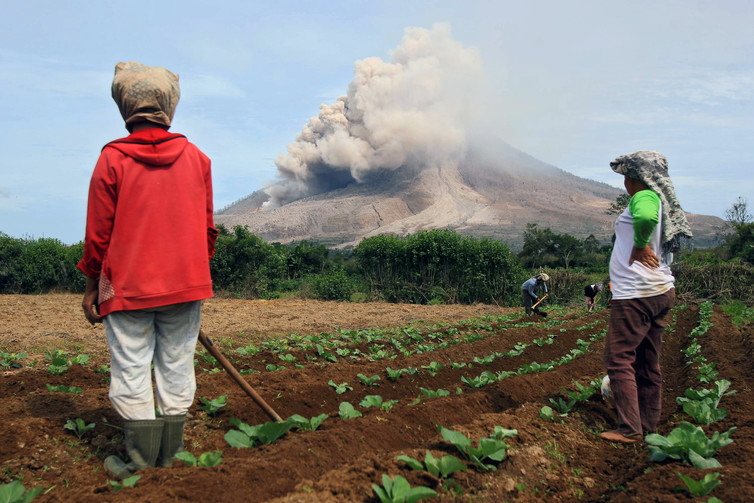Dedi Sinuhaji / EPA
Guest post by Gavin Sullivan, Centre for Research in Psychology, Behaviour and Achievement and Dr. Saut Sagala, School of Architecture, Planning and Policy Development, Bandung Institute of Technology
The latest eruption of Mount Sinabung in Sumatra killed seven people and injured two others. After lying dormant for 400 years, Sinabung has erupted several times since 2010 and is now Idonesia’s most active volcano. Locals have maintained a close watch as the official alert status has fluctuated, and thousands had already been evacuated long before the eruption.
But many villagers remained in the area – and outsiders may well wonder why, given the volcano’s recent history, people would not only live near the “red zone” (the restricted area within 3km of the summit) but also regularly venture into it. Surely local people know the risks of a “pyroclastic” cloud of superheated gas?
This is a question we’ve looked at in our research. The recent large eruption had an added personal component – we were leading a team that had been investigating why people continued to live near the red zone. Our researchers had been distributing questionnaires and conducting interviews in the village of Gamber and other villages bordering the red zone right up to the previous Tuesday, May 17.
On several occasions, smaller eruptions sent huge plumes of superheated gas into the sky as well as down the slopes of the mountain towards inhabited villages. We were cautious – we monitored the situation closely and were ready to evacuate quickly if we needed to. We witnessed these eruptions with a mixture of excitement, awe and fear. This contrasted with the calm and – sometimes – complete indifference of locals.
Sinabung rumbles away in Jun 2015…but local farmers appear unconcerned. Dedhi Sahputra / EPA
The main eruption on May 22 sent a pyroclastic flow 4.5kms down the mountain, eventually reaching Gamber. Our experience in the field and knowledge of the devastating effects of other eruptions and natural hazards in Indonesia – such as the eruption of Mount Merapi in 2010 – meant that the latest tragic deaths were, sadly, not a surprise to us.
Villagers regularly go into the red zone to farm their land, for instance. But the villages themselves can face the additional risk of “lahars”: potentially torrential flowing mixtures of water and rock fragments caused by heavy rainfall on the mountain. In the second week of our fieldwork, two children and one adult had been killed and a further child and adult were missing as a result of lahars not far from Gamber.
What next for communities around Sinabung?
While we are not yet ready to report on people’s thoughts and actions in the week prior to the latest eruptions, there are some preliminary answers. Previous research tells us the key factors explaining why people live in these dangerous situations are attachment to place and the protection of their livelihoods as well as a capacity to adapt to natural hazards and the reduced perception of risk that involves.
A recent review by the International Federation of Red Cross and Red Crescent Societies highlighted the need for external agencies and organisations to set aside their own conceptions of risk and engage seriously with the “alternative rationalities” of local people. Considerations about whether to stay, relocate independently or be relocated by the government to other locations should reflect the priorities of villagers and their community identities.
In the case of Gamber and other villages like it, many are reluctant to leave land owned by generations of ancestors as long as they can also continue to make a living from it. And, while people may not seem to fear being injured or killed by an eruption, we heard that some are less likely to visit their land within the red zone when there are no volunteer observers from a local group watching the mountain.
Our research at Mount Sinabung also tells us that people who have been permanently relocated from the red zone to new villages far from the mountain appear to have a better quality of life and less risk of health problems from dense ash clouds, for instance. In contrast, many people who have been temporarily evacuated to shelters (known as “Posko”) are in a desperate situation. They live in poor conditions with few offers of work and concerns about the quality of government-provided food. Some have now lived like this since 2010.
Villages outside the red zone have been designated safe by authorities but regular ash falls affect their health and reduce their ability to maintain farmland. For some, the ongoing eruptions will probably mean that their status as “refugees“ will change soon.
In this context, what impact can our research hope to have? Cultural change might occur by, for example, educating young people about the risks and encouraging them to change the activities of their parents. And we hope to provide evidence of how living so close to a volcano affects the psychology, health and well-being of villagers. This will turn, allow related interventions to be developed.
Our findings may also demonstrate the importance of community-led initiatives, such as volunteer groups formed of local villagers, in facilitating communications with authorities about imminent threats and the need to evacuate. Living near the volcano is dangerous and complicated but support and solutions are possible.
Originally written for ‘the Conversation’.





Comments are disabled